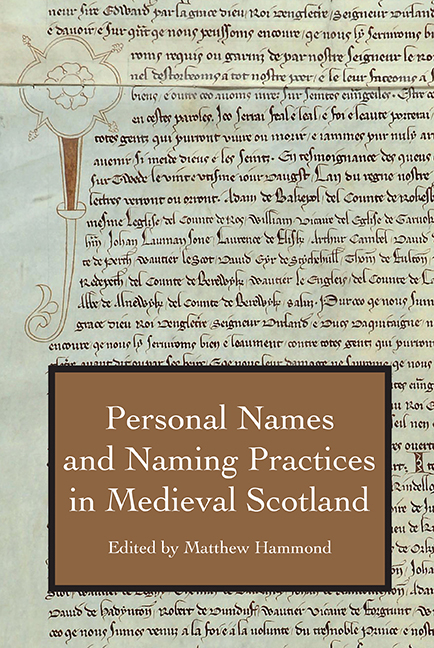Book contents
- Frontmatter
- Dedication
- Contents
- List of Tables
- Acknowledgements
- List of Contributors
- Abbreviations
- Note on the Text
- 1 Introduction: The Study of Personal Names in Medieval Scotland
- 2 Personal Names in Early Medieval Gaelic Chronicles
- 3 Gaelic Personal Names and Name Elements in Scottish Charters, 1093–1286
- 4 The Development of Mac Surnames in the Gaelic World
- 5 Forflissa/Forbflaith/Hvarflöð
- 6 Masculine Given Names of Germanic Origin in the Ragman Roll (1296)
- 7 The Romance of Names: Literary Personal Names in Twelfth- and Thirteenth-Century Scotland
- 8 Old Testament Personal Names in Scotland Before The Wars of Independence
- 9 Duthac Wigmore and Ninian Wallace: Scottish Saints and Personal Names in the later Middle Ages
- 10 Saints in Names in Late Medieval Argyll: a Preliminary Enquiry
- Bibliography
- Index
- Studies in Celtic History
1 - Introduction: The Study of Personal Names in Medieval Scotland
Published online by Cambridge University Press: 18 September 2019
- Frontmatter
- Dedication
- Contents
- List of Tables
- Acknowledgements
- List of Contributors
- Abbreviations
- Note on the Text
- 1 Introduction: The Study of Personal Names in Medieval Scotland
- 2 Personal Names in Early Medieval Gaelic Chronicles
- 3 Gaelic Personal Names and Name Elements in Scottish Charters, 1093–1286
- 4 The Development of Mac Surnames in the Gaelic World
- 5 Forflissa/Forbflaith/Hvarflöð
- 6 Masculine Given Names of Germanic Origin in the Ragman Roll (1296)
- 7 The Romance of Names: Literary Personal Names in Twelfth- and Thirteenth-Century Scotland
- 8 Old Testament Personal Names in Scotland Before The Wars of Independence
- 9 Duthac Wigmore and Ninian Wallace: Scottish Saints and Personal Names in the later Middle Ages
- 10 Saints in Names in Late Medieval Argyll: a Preliminary Enquiry
- Bibliography
- Index
- Studies in Celtic History
Summary
This book is about the names people had in medieval Scotland, and why they had them. Names mattered to medieval people. Parents sought to bestow some good fortune on their children through their choice of names. For many, this meant an expression of religious devotion through an appeal to the saints. These could be saints venerated locally, like Patrick or Margaret, or they could be ‘universal saints’ like Nicholas or Helen. Others chose to emphasize their lineage and family identity: the names Walter and Alan were common among the early Stewarts, while Robert was favoured by the Bruces and William by the Vieuxponts, and the earls of Strathearn liked Máel Ísu (Malise). Marriages often saw the names typical of the maternal line joining those of the paternal. The children of Gilla Brigte/Gilbert, earl of Strathearn, and his wife Matilda d'Aubigny were named Gilla Críst (Gilchrist), William, Ferteth, Robert, Fergus, Máel Ísu, Gilla Brigte, Matilda, Cecilia, and Eithne. William, the second son, was named after Matilda's father, and Robert, who became earl, was named after her maternal grandfather. Others sought to ingratiate themselves to their superiors by emulating the naming patterns of their lords: the knightly family of Ceres (FIF), tenants of the earls of Fife, copied their lords’ names Donnchad (Duncan), Máel Coluim (Malcolm) and Adam, and the lords of Lochore followed in their use of the name Constantine. A number of new lords who had been given lands through royal generosity named their children after kings; the names of David I (1124–53), Malcolm IV (1153–65), Alexander II (1214–49) and Alexander III (1249–86) were especially popular. Some had more whimsical leanings, evoking the imagery of popular literature and story-telling, giving rise to Arthurs and Merlins, Tristrams and Isoldes. Others chose to change their names in adulthood in order to express their personal piety, heroism or cultural preferences. Malachias and Nemias (Nehemiah), cathedral canons at Whithorn in the 1230s, very likely chose these as names in religion. Famously, Lachlan, lord of Galloway, preferred to be known by the name of the most famous heroic warrior in Christendom – Roland. Gilla Brigte, earl of Strathearn, and husband to Matilda d'Aubigny, seemed to prefer the French Gilbert. In this myriad of ways, names offer a window into the attitudes and personal choices of real people living in medieval Scotland.
- Type
- Chapter
- Information
- Publisher: Boydell & BrewerPrint publication year: 2019



